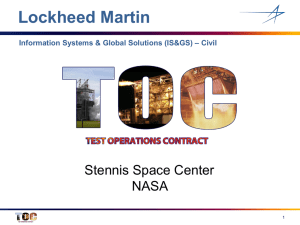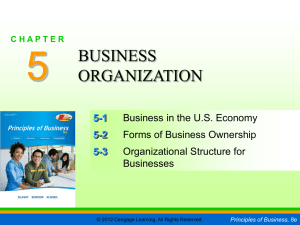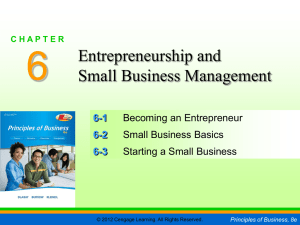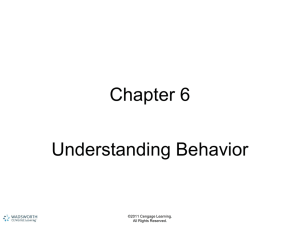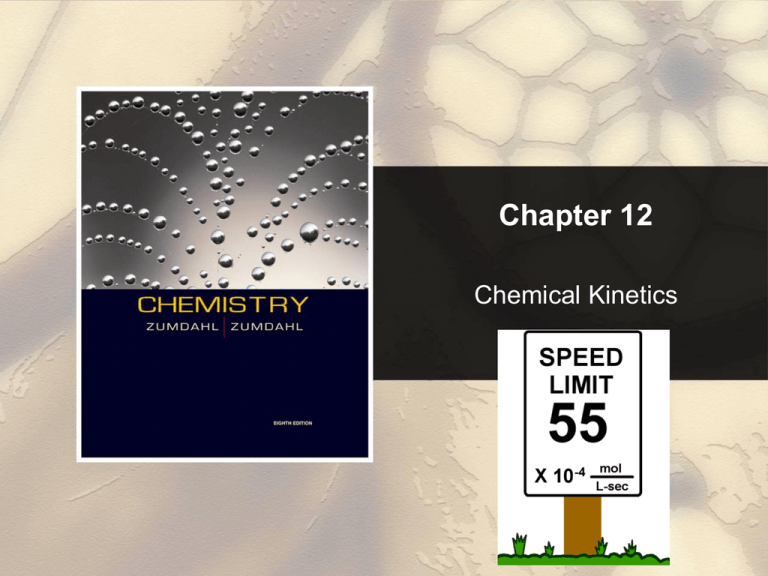
Chapter 12
Chemical Kinetics
Chapter 12
Table of Contents
12.1
12.2
12.3
12.4
12.5
12.6
12.7
Reaction Rates
Rate Laws: An Introduction
Determining the Form of the Rate Law
The Integrated Rate Law
Reaction Mechanisms
A Model for Chemical Kinetics
Catalysis
Copyright © Cengage Learning. All rights reserved
2
Section 12.1
Reaction Rates
Reaction Rate
• Change in concentration of a reactant or
product per unit time.
Rate =
=
concentration of A at time t2 concentration of A at time t1
t2 t1
A
t
[A] means concentration of A in mol/L; A is the
reactant or product being considered.
Return to TOC
Copyright © Cengage Learning. All rights reserved
3
Factors that Affect Reaction Rate
1. Temperature
•
•
Collision Theory: When two chemicals react, their
molecules have to collide with each other with sufficient
energy for the reaction to take place.
Kinetic Theory: Increasing temperature means the
molecules move faster.
2. Concentrations of reactants
•
More reactants mean more collisions if enough energy is
present
3. Catalysts
•
Speed up reactions by lowering activation energy
4. Surface area of a solid reactant
•
Bread and Butter theory: more area for reactants to be in
contact
5. Pressure of gaseous reactants or products
•
Increased number of collisions
A
B
time
[A]
rate = t
[B]
rate =
t
13.1
Section 12.1
Reaction Rates
Instantaneous Rate
• Value of the rate at a particular time.
• Can be obtained by computing the slope of a
line tangent to the curve at that point.
Return to TOC
Copyright © Cengage Learning. All rights reserved
6
Section 12.1
Reaction Rates
The Decomposition of Nitrogen Dioxide
Return to TOC
Copyright © Cengage Learning. All rights reserved
7
rate a [Br2]
rate = k [Br2]
rate
= rate constant
k=
[Br2]
= 3.50 x 10-3 s-1
13.1
Section 12.2
Atomic
Rate
Laws:
Masses
An Introduction
Rate Law
• Shows how the rate depends on the
concentrations of reactants.
• Rate = k[A]n[B]m…
• Example: For the decomposition of nitrogen
dioxide:
2NO2(g) → 2NO(g) + O2(g)
Rate = k[NO2]n:
k = rate constant
n, m = order of the individual reactant
Return to TOC
Copyright © Cengage Learning. All rights reserved
9
Section 12.2
Atomic
Rate
Laws:
Masses
An Introduction
Rate Law
Rate = k[NO2]n
• The concentrations of the products do not
appear in the rate law because the reaction rate
is being studied under conditions where the
reverse reaction does not contribute to the
overall rate.
Return to TOC
Copyright © Cengage Learning. All rights reserved
10
Section 12.2
Atomic
Rate
Laws:
Masses
An Introduction
Rate Law
Rate = k[NO2]n
• The value of the exponent n must be
determined by experiment; it cannot be written
from the balanced equation.
Return to TOC
Copyright © Cengage Learning. All rights reserved
11
Section 12.2
Atomic
Rate
Laws:
Masses
An Introduction
Types of Rate Laws
• Differential Rate Law (rate law) – shows how
the rate of a reaction depends on
concentrations.
• Integrated Rate Law – shows how the
concentrations of species in the reaction
depend on time.
Return to TOC
Copyright © Cengage Learning. All rights reserved
12
Section 12.2
Atomic
Rate
Laws:
Masses
An Introduction
Rate Laws: A Summary
• Because we typically consider reactions only
under conditions where the reverse reaction is
unimportant, our rate laws will involve only
concentrations of reactants.
• Either type of rate law is fine to use
Return to TOC
Copyright © Cengage Learning. All rights reserved
13
Section 12.2
Atomic
Rate
Laws:
Masses
An Introduction
Rate Laws: A Summary
• Experimental convenience usually dictates
which type of rate law is determined
experimentally.
• Knowing the rate law for a reaction is important
mainly because we can usually infer the
individual steps involved in the reaction from the
specific form of the rate law.
Return to TOC
Copyright © Cengage Learning. All rights reserved
14
Section 12.3
The Mole
Determining
the Form of the Rate Law
• Determine experimentally the power to which
each reactant concentration must be raised in
the rate law.
Return to TOC
Copyright © Cengage Learning. All rights reserved
15
Section 12.3
The Mole
Determining
the Form of the Rate Law
Method of Initial Rates
• The value of the initial rate is determined for
each experiment at the same value of t as close
to t = 0 as possible.
• Several experiments are carried out using
different initial concentrations of each of the
reactants, and the initial rate is determined for
each run.
• The results are then compared to see how the
initial rate depends on the initial concentrations
of each of the reactants.
Return to TOC
Copyright © Cengage Learning. All rights reserved
16
Section 12.3
The Mole
Determining
the Form of the Rate Law
Overall Reaction Order
• The sum of the exponents in the reaction rate
equation.
Rate = k[A]n[B]m…
Overall reaction order = n + m…
k = rate constant
[A] = concentration of reactant A
[B] = concentration of reactant B
Copyright © Cengage Learning. All rights reserved
Return to TOC
17
F2 (g) + 2ClO2 (g)
2FClO2 (g)
rate = k [F2]x[ClO2]y
Double [F2] with [ClO2] constant
Rate doubles
x=1
Quadruple [ClO2] with [F2] constant
rate = k [F2][ClO2]
Rate quadruples
y=1
13.2
Run # Initial [A]
([A]0)
Initial [B]
([B]0)
Initial Rate (v0)
1
1.00 M
1.00 M
1.25 x 10-2 M/s
2
1.00 M
2.00 M
2.5 x 10-2 M/s
3
2.00 M
2.00 M
2.5 x 10-2 M/s
What is the order with respect to A?
0
What is the order with respect to B?
1
What is the overall order of the
reaction?
1
[NO(g)] (mol
dm-3)
[Cl2(g)] (mol
dm-3)
Initial Rate
(mol dm-3 s-1)
0.250
0.250
1.43 x 10-6
0.250
0.500
2.86 x 10-6
0.500
0.500
1.14 x 10-5
What is the order with respect to Cl2?
1
What is the order with respect to NO?
2
What is the overall order of the
reaction?
3
Determine the rate law and calculate the rate constant for
the following reaction from the following data:
S2O82- (aq) + 3I- (aq)
2SO42- (aq) + I3- (aq)
Experiment
[S2O82-]
[I-]
Initial Rate
(M/s)
1
0.08
0.034
2.2 x 10-4
2
0.08
0.017
1.1 x 10-4
3
0.16
0.017
2.2 x 10-4
rate = k [S2O82-]x[I-]y
y=1
x=1
rate = k [S2O82-][I-]
Double [I-], rate doubles (experiment 1 & 2)
Double [S2O82-], rate doubles (experiment 2 & 3)
2.2 x 10-4 M/s
rate
k=
=
= 0.08/M•s
2[S2O8 ][I ] (0.08 M)(0.034 M)
13.2
Section 12.4
The Integrated Rate Law
First-Order
• Rate = k[A]
• Integrated:
ln[A] - ln[A]o = –kt
(form of “Pert”)
[A] = concentration of A at time t
k = rate constant
t = time
[A]o = initial concentration of A
Return to TOC
Copyright © Cengage Learning. All rights reserved
22
First-Order Reactions
[A]
rate = t
rate = k [A]
[A] = [A]0e-kt
[A] is the concentration of A at any time t
ln[A] - ln[A]0 = - kt
[A]0 is the concentration of A at time t=0
13.3
The reaction 2A
B is first order in A with a rate
constant of 2.8 x 10-2 s-1 at 800C. How long will it take for A
to decrease from 0.88 M to 0.14 M ?
[A] = [A]0e-kt
[A]0 = 0.88 M
ln[A] - ln[A]0 = - kt
[A] = 0.14 M
ln[A]0 - ln[A] = kt
ln[A]0 – ln[A]
=
t=
k
ln
[A]0
[A]
k
ln
=
0.88 M
0.14 M
2.8 x
10-2
s-1
= 66 s
13.3
Section 12.4
The Integrated Rate Law
Half-Life of Reactions
Return to TOC
Copyright © Cengage Learning. All rights reserved
25
Section 12.4
The Integrated Rate Law
First-Order
• Half–Life:
t1
2
0.693
=
k
k = rate constant
Return to TOC
Copyright © Cengage Learning. All rights reserved
26
First-Order Reactions
The half-life, t½, is the time required for the concentration of a
reactant to decrease to half of its initial concentration.
t½ = t when [A] = [A]0/2
ln
t½ =
[A]0
[A]0/2
k
Ln 2 0.693
=
=
k
k
What is the half-life of N2O5 if it decomposes with a rate
constant of 5.7 x 10-4 s-1?
0.693
t½ = Ln 2 =
= 1200 s = 20 minutes
-4
-1
k
5.7 x 10 s
How do you know decomposition is first order?
units of k (s-1)
13.3
Second-Order Reactions
[A]
rate = t
1
1
= kt
[A]
[A]0
rate = k [A]2 [A] is the concentration of A at any time t
[A]0 is the concentration of A at time t=0
Half life for second order
t½ = t when [A] = [A]0/2
1
t½ =
k[A]0
13.3
Section 12.4
The Integrated Rate Law
Second-Order
• Half–life gets longer as the reaction progresses
and the concentration of reactants decrease.
• Each successive half–life is double the
preceding one.
Return to TOC
Copyright © Cengage Learning. All rights reserved
29
Zero-Order Reactions
[A]
rate = t
[A] - [A]0 = -kt
rate = k [A]0 = k
[A] is the concentration of A at any time t
[A]0 is the concentration of A at time t=0
Half life for zero order
t½ = t when [A] = [A]0/2
[A]0
t½ =
2k
13.3
Section 12.4
The Integrated Rate Law
Summary of the Rate Laws
Return to TOC
Copyright © Cengage Learning. All rights reserved
31
Section 12.5
Reaction Mechanisms
Reaction Mechanism
• Most chemical reactions occur by a series
of elementary steps.
• An intermediate is formed in one step and
used up in a subsequent step and thus is
never seen as a product in the overall
balanced reaction.
Return to TOC
Copyright © Cengage Learning. All rights reserved
32
Reaction Intermediates
Intermediates are species that appear in a reaction
mechanism but not in the overall balanced equation.
An intermediate is always formed in an early elementary step
and consumed in a later elementary step.
Elementary step:
NO + NO
N 2O 2
+ Elementary step:
N2O2 + O2
2NO2
Overall reaction:
2NO + O2
2NO2
13.5
A catalyst is a substance that increases the rate of a
chemical reaction without itself being consumed. It is used in
an earlier step, and then later produced.
k
Ea
uncatalyzed
catalyzed
ratecatalyzed > rateuncatalyzed
An inhibitor RAISES the activation energy
13.6
Section 12.5
Reaction Mechanisms
A Molecular Representation of the Elementary Steps in the
Reaction of NO2 and CO
NO2(g) + CO(g) → NO(g) + CO2(g)
Return to TOC
Copyright © Cengage Learning. All rights reserved
35
Section 12.5
Reaction Mechanisms
Elementary Steps (Molecularity)
• Unimolecular – reaction involving one
molecule; first order.
• Bimolecular – reaction involving the
collision of two species; second order.
• Termolecular – reaction involving the
collision of three species; third order.
Return to TOC
Copyright © Cengage Learning. All rights reserved
36
Section 12.5
Reaction Mechanisms
Rate-Determining Step
• A reaction is only as fast as its slowest
step.
• The rate-determining step (slowest
step) determines the rate law and the
molecularity of the overall reaction.
Return to TOC
Copyright © Cengage Learning. All rights reserved
37
Section 12.5
Reaction Mechanisms
Reaction Mechanism Requirements
• The sum of the elementary steps must give
the overall balanced equation for the
reaction.
• The mechanism must agree with the
experimentally determined rate law.
Return to TOC
Copyright © Cengage Learning. All rights reserved
38
Section 12.5
Reaction Mechanisms
Decomposition of N2O5
Return to TOC
Copyright © Cengage Learning. All rights reserved
39
Section 12.5
Reaction Mechanisms
Decomposition of N2O5
2N2O5(g) 4NO2(g) + O2(g)
Step 1: 2(N2O5
NO2 + NO3 )
(fast)
Step 2: NO2 + NO3 → NO + O2 + NO2 (slow)
Step 3: NO3 + NO → 2NO2
(fast)
Return to TOC
Copyright © Cengage Learning. All rights reserved
40
The experimental rate law for the reaction between NO2
and CO to produce NO and CO2 is rate = k[NO2]2. The
reaction is believed to occur via two steps:
Step 1:
NO2 + NO2
NO + NO3
Step 2:
NO3 + CO
NO2 + CO2
What is the equation for the overall reaction?
NO2+ CO
NO + CO2
What is the intermediate? Catalyst?
NO3
NO2
What can you say about the relative rates of steps 1 and 2?
rate = k[NO2]2 is the rate law for step 1 so
step 1 must be slower than step 2
13.5
Write the rate law for this reaction.
Rate = k [HBr] [O2]
List all intermediates in this reaction.
HOOBr, HOBr
List all catalysts in this reaction.
None
Section 12.5
Reaction Mechanisms
Concept Check
The reaction A + 2B C has the following
proposed mechanism:
A+B
D
(fast equilibrium)
D+BC
(slow)
Write the rate law for this mechanism.
rate = k[A][B]2
Return to TOC
Copyright © Cengage Learning. All rights reserved
43
Section 12.7
Catalysis
Homogeneous Catalyst
• Exists in the same phase as the reacting
molecules.
• Enzymes are nature’s catalysts.
Return to TOC
Copyright © Cengage Learning. All rights reserved
44
Section 12.7
Catalysis
Homogeneous Catalysis
Return to TOC
Copyright © Cengage Learning. All rights reserved
45
Ostwald Process
4NH3 (g) + 5O2 (g)
Pt catalyst
2NO (g) + O2 (g)
2NO2 (g) + H2O (l)
4NO (g) + 6H2O (g)
2NO2 (g)
HNO2 (aq) + HNO3 (aq)
Pt-Rh catalysts used
in Ostwald process
Hot Pt wire
over NH3 solution
13.6
Catalytic Converters
CO + Unburned Hydrocarbons + O2
2NO + 2NO2
catalytic
converter
catalytic
converter
CO2 + H2O
2N2 + 3O2
13.6
Enzyme Catalysis
13.6
Section 12.6
A Model for Chemical Kinetics
Collision Model
• Molecules must collide to react.
• Main Factors:
Activation energy, Ea
Temperature
Molecular orientations
Return to TOC
Copyright © Cengage Learning. All rights reserved
49
Section 12.6
A Model for Chemical Kinetics
Transition States and Activation Energy
Return to TOC
Copyright © Cengage Learning. All rights reserved
50
Section 12.6
A Model for Chemical Kinetics
Change in Potential Energy
Return to TOC
Copyright © Cengage Learning. All rights reserved
51
Section 12.6
A Model for Chemical Kinetics
For Reactants to Form Products
• Collision must involve enough energy to
produce the reaction (must equal or
exceed the activation energy).
• Relative orientation of the reactants must
allow formation of any new bonds
necessary to produce products.
Return to TOC
Copyright © Cengage Learning. All rights reserved
52
Section 12.6
A Model for Chemical Kinetics
Arrhenius Equation
k = Ae
Ea / RT
A
Ea
R
T
=
=
=
=
frequency factor
activation energy
gas constant (8.3145 J/K·mol)
temperature (in K)
Return to TOC
Copyright © Cengage Learning. All rights reserved
53
Section 12.6
A Model for Chemical Kinetics
Linear Form of Arrhenius Equation
Ea 1
ln(k ) = + ln A
R T
Return to TOC
Copyright © Cengage Learning. All rights reserved
54
Section 12.6
A Model for Chemical Kinetics
Linear Form of Arrhenius Equation
Return to TOC
Copyright © Cengage Learning. All rights reserved
55

